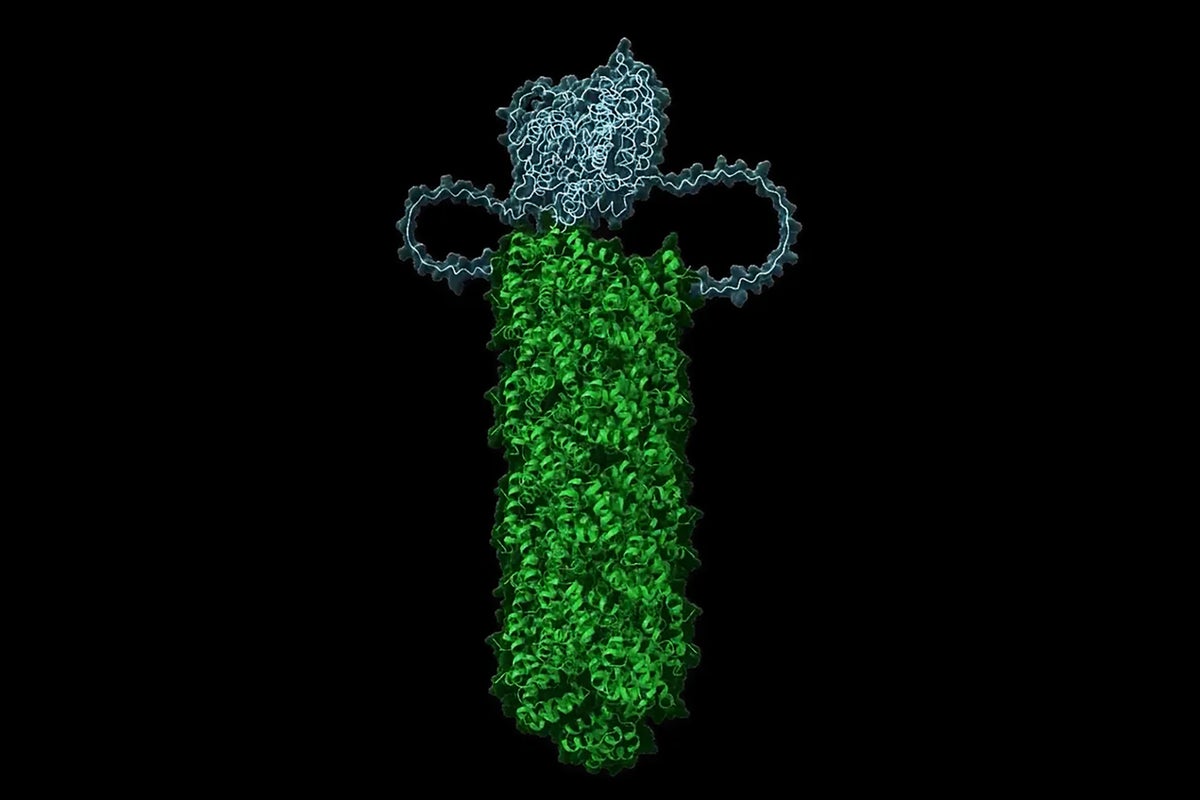Cells Have a Crystal Trigger That Makes Them Self-Destruct When Viruses Invade
A special class of immune proteins protect us from pathogens but also drive inflammation and cell death
A model showing proteins called death fold domains (green) telling a caspase enzyme (blue) to kill the cell after it has been compromised by pathogens.
The immune system has a tough job: When a tiny virus invades one of our cells, that cell must detect it and, within minutes, decide what to do. If the cell quickly self-destructs, that will prevent the virus from spreading throughout the body. But such a response to a false alarm will mean the cell will die unnecessarily.
Now researchers have discovered that a special group of about 100 immune proteins hangs out inside every cell in the body, where these proteins do nothing but wait. Then, when a virus breaks in, it seeds a crystal, and the proteins instantly clump around it, forming a scaffold for enzymes known as caspases to activate and immediately initiate cell death. (The caspases must be brought together to kill the cell; it is their proximity to one another that activates them.) The kind of cell death caused by this mechanism is called pyroptosis, and unlike apoptosis (programmed cell death), it triggers inflammation.
“What we found, in essence, is that the cells are literally waiting to die all the time,” says Randal Halfmann, an associate investigator at the Stowers Institute for Medical Research. Halfmann oversaw the work, which was published in eLife in September.
If you’re enjoying this article, consider supporting our award-winning journalism by subscribing. By purchasing a subscription you are helping to ensure the future of impactful stories about the discoveries and ideas shaping our world today.
Historically, scientists have studied proteins’ folded structures to understand their function individually. But “we’re in this explosion of discovery, realizing that these individual molecules that we’ve studied so well are coming together into larger structures that are not bound by membranes,” says D. Allan Drummond, a molecular biologist at the University of Chicago, who was not involved in the study. This new understanding has prompted “new kinds of ways of thinking about cellular function and decision-making by cells, new ways for them to store energy, and so on.”
Halfmann’s team quantified the driving force for these proteins to crystallize in different human cell types and found that their concentration is correlated with the rate of cell turnover in our body. For example, some blood cells are replaced every few days, whereas neurons often last a lifetime. The faster cells normally turn over, the more of these immune proteins they tend to have, suggesting that this process of spontaneous activation might be responsible for killing them.
These results suggest that these immune proteins might be contributing to the low-grade inflammation that accompanies aging. Finding ways to keep the proteins from crystallizing could potentially extend cells’ lifespan and reduce aging-related inflammation, but the trade-off would be a weaker immune system, Halfmann says.
This feature of the immune system is very ancient. It is found in the earliest animals, such as sponges, and it even exists in bacteria, from which we likely inherited it. It is specifically found in some bacteria that live in tight-knit communities. “If you’re a single-celled organism, there’s no drive to kill yourself,” Halfmann says. “But when you’re part of a community and you’re compromised by a phage [a virus that kills bacteria], then it absolutely makes sense to kill yourself because you’re related to everybody around you, and that is where these proteins seem to have evolved.”
Viviane Callier is a freelance science writer based in North Bethesda, Md.
If you enjoyed this article, I’d like to ask for your support. Scientific American has served as an advocate for science and industry for 180 years, and right now may be the most critical moment in that two-century history.
I’ve been a Scientific American subscriber since I was 12 years old, and it helped shape the way I look at the world. SciAm always educates and delights me, and inspires a sense of awe for our vast, beautiful universe. I hope it does that for you, too.
If you , you help ensure that our coverage is centered on meaningful research and discovery; that we have the resources to report on the decisions that threaten labs across the U.S.; and that we support both budding and working scientists at a time when the value of science itself too often goes unrecognized.
In return, you get essential news, captivating podcasts, brilliant infographics, , must-watch videos, challenging games, and the science world’s best writing and reporting. You can even gift someone a subscription.
There has never been a more important time for us to stand up and show why science matters. I hope you’ll support us in that mission.
Thank you,
David M. Ewalt, Editor in Chief, Scientific American
Source: www.scientificamerican.com
